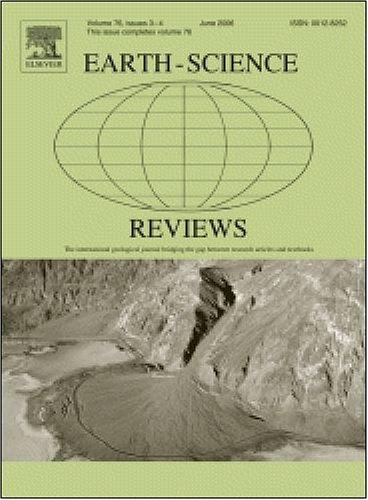The geomorphology of monoclinal scarps associated with interstratal-dissolution fronts in evaporite formations, illustrated with the Upper Jurassic Arab and Hith formations in Ar Riyadh and Central Saudi Arabia
IF 10.8
1区 地球科学
Q1 GEOSCIENCES, MULTIDISCIPLINARY
引用次数: 0
Abstract
The downdip migration of dissolution fronts in gently tilted evaporite formations produces updip-facing monoclinal folds and adjacent synformal troughs (depositional basins) in the supra-evaporite strata. These gravitational deformation structures, up to 1000 km long, can be expressed in the landscape as laterally migrating fold escarpments and linear depressions, forming the largest karst features on Earth. Despite their large dimensions and numerous associated practical implications (hydrocarbon, salt, geostorage, water quality, sinkhole hazards), the scientific publications dealing with these interstratal evaporite karst features are rather scarce. This work reviews the available literature on dissolutional edges and associated features developed on dipping salt and gypsum/anhydrite formations. It also analyses the >800 km long dissolution and subsidence belt associated with the updip edge of the Upper Jurassic Arab and Hith anhydrites in the Interior Homocline of central Saudi Arabia, with special focus on its striking geomorphic features. This is the largest Ca-sulphate karst feature in the world, despite the aridity of the region, and is also the example in which the associated landforms and deformation structures are best displayed. It displays striking monoclinal scarps with an aggregate length of 420 km, affected by crestal extensional structures and punctured by numerous giant caprock collapse sinkholes. The increased sinkhole hazard and risk documented in the Ar Riyadh area in recent times can be attributed to adverse human activities (localized artificial water input) and the expansion of the urban area across the dissolution front and monoclinal scarp.
蒸发岩地层中与层间溶蚀锋相关的单斜陡坡地貌,以利雅得和沙特阿拉伯中部的上侏罗统阿拉伯和希斯地层为例
缓倾斜蒸发岩地层中溶蚀锋面的下倾运移在上蒸发岩地层中形成面向上的单斜褶皱和相邻的同型槽(沉积盆地)。这些重力变形构造长达1000公里,在景观中表现为横向迁移的褶皱峭壁和线状洼地,形成了地球上最大的喀斯特地貌。尽管它们的规模很大,并有许多相关的实际意义(碳氢化合物、盐、地质储存、水质、天坑危害),但涉及这些蒸发岩间岩溶特征的科学出版物相当少。本文综述了有关浸盐和石膏/硬石膏地层的溶解边缘及其相关特征的现有文献。分析了沙特阿拉伯中部内同斜带中与上侏罗统阿拉伯硬石膏和希斯硬石膏上斜缘有关的800 km长的溶蚀沉降带,重点分析了其显著的地貌特征。尽管该地区干旱,但这是世界上最大的硫酸钙喀斯特地貌,也是相关地貌和变形结构最好展示的例子。它显示了引人注目的单斜陡坡,总长度为420公里,受顶部伸展构造的影响,并被许多巨大的盖层崩塌陷坑所穿透。最近在利雅得地区记录的天坑危害和风险增加可归因于不利的人类活动(局部人工水输入)以及城市面积在溶解锋和单斜陡坡上的扩大。
本文章由计算机程序翻译,如有差异,请以英文原文为准。
求助全文
约1分钟内获得全文
求助全文
来源期刊

Earth-Science Reviews
地学-地球科学综合
CiteScore
21.70
自引率
5.80%
发文量
294
审稿时长
15.1 weeks
期刊介绍:
Covering a much wider field than the usual specialist journals, Earth Science Reviews publishes review articles dealing with all aspects of Earth Sciences, and is an important vehicle for allowing readers to see their particular interest related to the Earth Sciences as a whole.
 求助内容:
求助内容: 应助结果提醒方式:
应助结果提醒方式:


